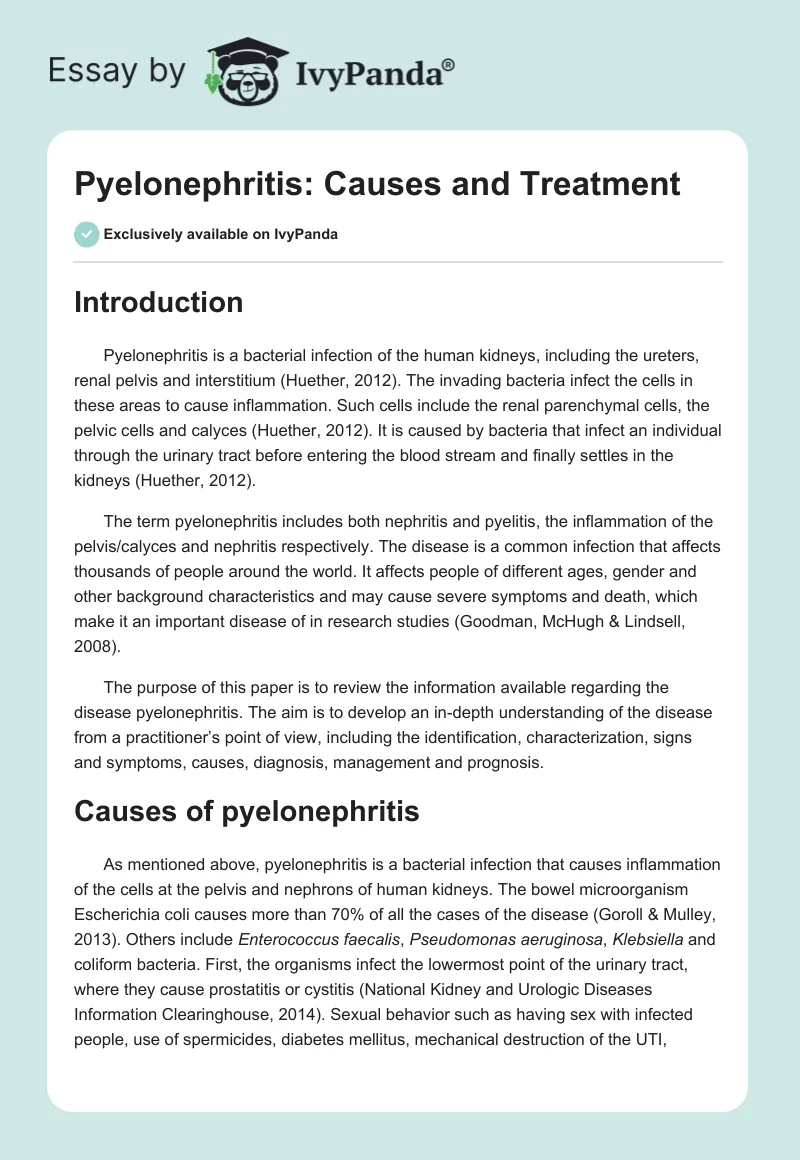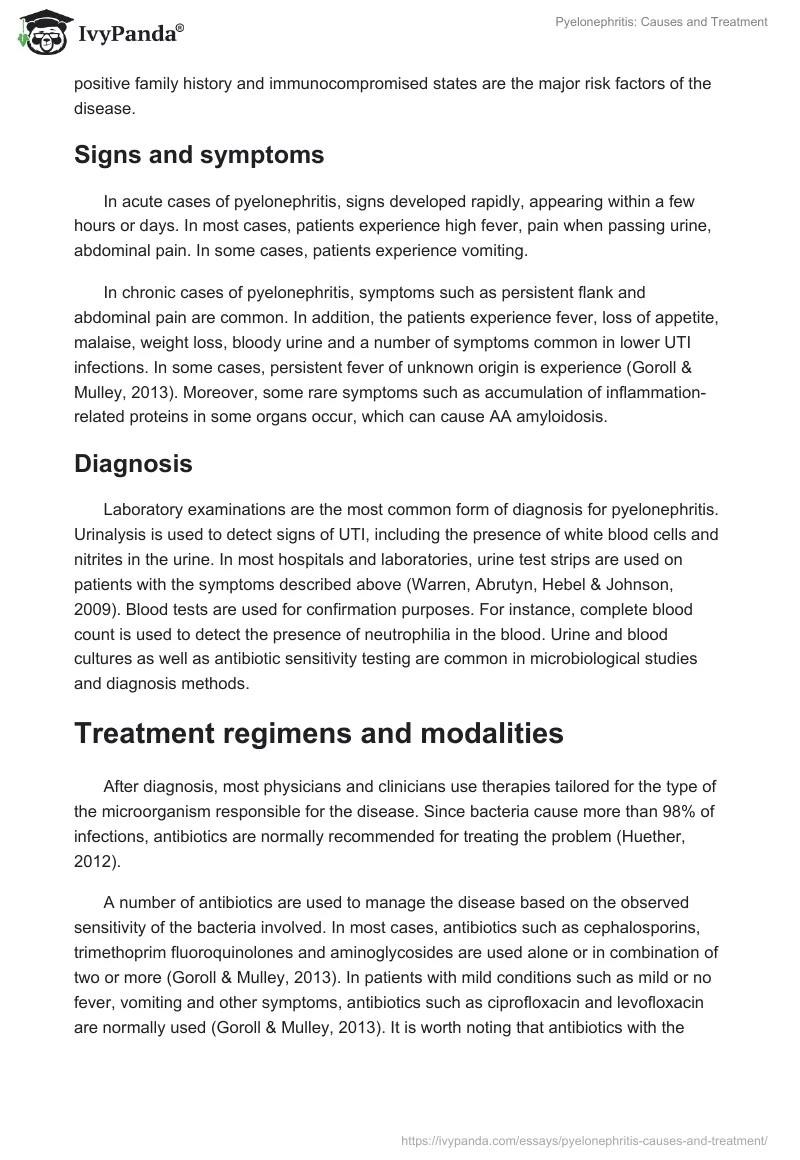Introduction
Pyelonephritis is a bacterial infection of the human kidneys, including the ureters, renal pelvis and interstitium (Huether, 2012). The invading bacteria infect the cells in these areas to cause inflammation. Such cells include the renal parenchymal cells, the pelvic cells and calyces (Huether, 2012). It is caused by bacteria that infect an individual through the urinary tract before entering the blood stream and finally settles in the kidneys (Huether, 2012).
The term pyelonephritis includes both nephritis and pyelitis, the inflammation of the pelvis/calyces and nephritis respectively. The disease is a common infection that affects thousands of people around the world. It affects people of different ages, gender and other background characteristics and may cause severe symptoms and death, which make it an important disease of in research studies (Goodman, McHugh & Lindsell, 2008).
The purpose of this paper is to review the information available regarding the disease pyelonephritis. The aim is to develop an in-depth understanding of the disease from a practitioner’s point of view, including the identification, characterization, signs and symptoms, causes, diagnosis, management and prognosis.
Causes of pyelonephritis
As mentioned above, pyelonephritis is a bacterial infection that causes inflammation of the cells at the pelvis and nephrons of human kidneys. The bowel microorganism Escherichia coli causes more than 70% of all the cases of the disease (Goroll & Mulley, 2013). Others include Enterococcus faecalis, Pseudomonas aeruginosa, Klebsiella and coliform bacteria. First, the organisms infect the lowermost point of the urinary tract, where they cause prostatitis or cystitis (National Kidney and Urologic Diseases Information Clearinghouse, 2014). Sexual behavior such as having sex with infected people, use of spermicides, diabetes mellitus, mechanical destruction of the UTI, positive family history and immunocompromised states are the major risk factors of the disease.
Signs and symptoms
In acute cases of pyelonephritis, signs developed rapidly, appearing within a few hours or days. In most cases, patients experience high fever, pain when passing urine, abdominal pain. In some cases, patients experience vomiting.
In chronic cases of pyelonephritis, symptoms such as persistent flank and abdominal pain are common. In addition, the patients experience fever, loss of appetite, malaise, weight loss, bloody urine and a number of symptoms common in lower UTI infections. In some cases, persistent fever of unknown origin is experience (Goroll & Mulley, 2013). Moreover, some rare symptoms such as accumulation of inflammation-related proteins in some organs occur, which can cause AA amyloidosis.
Diagnosis
Laboratory examinations are the most common form of diagnosis for pyelonephritis. Urinalysis is used to detect signs of UTI, including the presence of white blood cells and nitrites in the urine. In most hospitals and laboratories, urine test strips are used on patients with the symptoms described above (Warren, Abrutyn, Hebel & Johnson, 2009). Blood tests are used for confirmation purposes. For instance, complete blood count is used to detect the presence of neutrophilia in the blood. Urine and blood cultures as well as antibiotic sensitivity testing are common in microbiological studies and diagnosis methods.
Treatment regimens and modalities
After diagnosis, most physicians and clinicians use therapies tailored for the type of the microorganism responsible for the disease. Since bacteria cause more than 98% of infections, antibiotics are normally recommended for treating the problem (Huether, 2012).
A number of antibiotics are used to manage the disease based on the observed sensitivity of the bacteria involved. In most cases, antibiotics such as cephalosporins, trimethoprim fluoroquinolones and aminoglycosides are used alone or in combination of two or more (Goroll & Mulley, 2013). In patients with mild conditions such as mild or no fever, vomiting and other symptoms, antibiotics such as ciprofloxacin and levofloxacin are normally used (Goroll & Mulley, 2013). It is worth noting that antibiotics with the beta-lactam ring in their biochemical structures are not effective in treating pyelonephritis.
Outpatient care is recommended for the patients who do not have complicated infections. Acute cases of pyelonephritis are normally treated using outpatient care, where single doses of parenteral antibiotics and oral therapies are recommended. However, the treatment must be monitored within the first 48 hours of treatment.
Inpatient care is recommended for patients with sever conditions and complications of the disease. For instance, acute cases of pyelonephritis require hospitalization and include supportive care, monitoring of comorbid conditions to avoid deterioration, monitoring of blood and urine culture and maintenance of hydration using IV fluids in patients with severe cases of the infection.
Apart from drug therapies, survey is normally recommended in severe cases of pyelonephritis. For instance, patients with abscesses such as renal cortical, renal corticomedullary abscess and perinephreic abscess as well as those with renal papillary necrosis, calcculiprelated UTI and xanthogranomalotus pyenonephritis must undergo surgery to remove these abscesses (Goroll & Mulley, 2013).
Prognosis
In pregnant women, premature labor is likely to occur in cases of acute and severe pyelonephritis. In particular, premature labor occurs in the late pregnancy, especially when appropriate treatment and management of the condition is not provided. Other patients may have an uncomplicated recovery process unless there are some significant comorbidities that may affect the healing process (Goodman, McHugh & Lindsell, 2008).
The prevention of the condition includes prophylaxis for female patients who have at least three or four symptoms of pyelonephritis infections in 12 months (Goodman, McHugh & Lindsell, 2008). It is recommended that antibiotic prophylaxis be reserved for a considerable period, especially in patients who are at high risk of developing complications. For instance, antibiotic prophylaxis should be reserved for the children who demonstrate vesicuoureteric reflux, renal scarring or recurrent infections after imaging has been done (Goodman, McHugh & Lindsell, 2008).
In chronic cases, studies indicate that more than ¼ of the children with veicuoreteral reflux are likely to develop chronic renal failure (Goodman, McHugh & Lindsell, 2008). In addition, about 30% of them are likely to proceed to hypertension (Goodman, McHugh & Lindsell, 2008). On the other hand, adults with chronic pyelonephritis do not have complications. In most adult patients, the renal functioning is normal.
Prevention of chronic cases of the disease includes providing people with information regarding the common methods used to prevent UTIs because it is assumed that most cases of the disease is due to the bacterial infections that ascend the urinary tract (Goodman, McHugh & Lindsell, 2008). In addition, women at risk should be encouraged to avoid sexual intercourse until the risks have been mitigated.
Conclusion
Like most other bacterial infection, pyelonephritis is a treatable disease. In addition, it is similar to other UTI infections because it affects the urinary tract after infection. However, it is worth noting that the bacteria species involved cause harm in vital organs like the kidneys, which leads to severe cases such as kidney failure. Therefore, knowing the causes, symptoms, prognosis and prevention are the most important method of creating awareness and decreasing the prevalence of the disease. However, treatment is necessary to care for the infected people and ensure that they are provided with the right regimens in order to prevent recurrent cases (Goodman, McHugh & Lindsell, 2008).
Moreover, it is necessary to ensure that people are aware of the methods that should be used to reduce the risks, including involving the right behavior, early diagnosis and prognosis, prevention of mechanical injuries in the urinary tract system and some sexual behavior. In addition, it is important to ensure that hospitals are aware that some bacteria are acquired the hospitals. In this way, it is possible to reduce the risks of hospital-acquired cases of pyelonephritis.
References
Goodman, T. R., McHugh, K., & Lindsell D. R. (2008). Paediatric xanthogranulomatous pyelonephritis. International Journal of Clinical Practice 52(1), 43–5.
Goroll, A. H., & Mulley, A. G. (2013). Primary care medicine: office evaluation and management of the adult patient. Philadelphia: Lippincott Williams & Wilkins.
Huether, S. E. (2012). Alterations of Renal and Urinary Tract Function. In S. E. Huether & K. L. McCance, Understanding pathophysiology (5th ed., pp. 741-771). St. Louis, MO: Elsevier Mosby
National Kidney and Urologic Diseases Information Clearinghouse. (2014). Pyelonephritis: Kidney infection. Web.
Warren, J. W., Abrutyn, E., Hebel, J. R., & Johnson, J. R., (2009). Guidelines for antimicrobial treatment of uncomplicated acute bacterial cystitis and acute pyelonephritis in women. Clinical Infectious Diseases, 29(4), 745-759.


